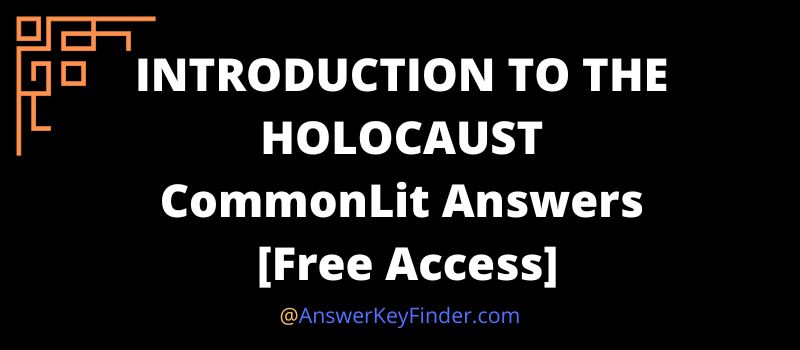In this session, we will be revealing INTRODUCTION TO THE HOLOCAUST CommonLit answers which are absolutely FREE to view.
Before publishing, every answer for INTRODUCTION TO THE HOLOCAUST CommonLit article undergoes a thorough review to ensure its accuracy & reliability. If you find them helpful, please don’t hesitate to share.
INTRODUCTION TO THE HOLOCAUST CommonLit Answers Key – FREE Access
Find the answer key for the topic “INTRODUCTION TO THE HOLOCAUST” below:
Note: Be prepared to share your original ideas in a class discussion.

Discussion Questions & Answers
Following are our answers based on the questions provided:
Q.1. The Nazis and people who agreed with them wanted to protect the German community from “inferior” races. Are there other examples in history or literature in which groups of people murdered innocent people in the name of “protecting” themselves? How are these examples similar to or different from the Holocaust?
Ans: An example in history or literature in which groups of people murdered innocent people in the name of “protecting” themselves is the killing of native Indians in the European colonization of the Americas. The native Indians were seen as bloodthirsty savages by the settling Europeans. To protect themselves as they would see it, they murdered millions of native Indians.
Q.2. What might have made the Nazis murder, imprison, and oppress certain people? Do you think those people were really a threat, or could there have been other motivations?
Ans: The Nazis murdered, imprison, and oppress certain people because they saw them as a threat to their communities. They justified their actions as a way for them to protect themselves. I don’t think those people were really a threat or could have been other motivations, they were just seen as wrong aliens by the Germans.
Q.3. In the context of this article, what makes people do bad things? Cite evidence from this text, your own experience, and other literature, art, or history in your answer.
Ans: In the context of this article, people do bad things in order to protect themselves. The Germans saw themselves as superior to other races and saw other people as an “alien threat to the so-called German racial community.” They believed what they were doing was for the best of their own people, even if it killed millions of people in the process.
Q.4. The Holocaust is taught in history classes today so that people will never forget. Although it is not pleasant to hear about the murder of millions of people because of their religion, race, or beliefs, educators believe it is important to study. What can we learn from tragedy, and why is it important to study tragic history?
Ans: We can learn from tragedy the mistakes that were made that led to those tragedies. It is very important to study tragic history so that we can learn from our mistakes and similar events do not occur again. The Holocaust and other similar genocides need to be taught more so that our futures are more harmonized than theirs.
Assessment Questions & Answers
Following are our answers based on the questions provided:
Q.1. Which of the following best describes the central idea of the text?
Ans: Nazi Germany killed millions of Jews and other targeted groups during the Holocaust.
Q.2. What is the meaning of “deplorable” in paragraph 5?
Ans: Horrible
Q.3. How does paragraph 5 contribute to the discussion of the Holocaust in the text?
Ans: It highlights the extent of the Nazi regime’s persecution and violence against many groups of people.
Q.4. PART A: What does the word “concentrate” most closely mean as it is used in paragraph 8?
Ans: Gather
Q.5. PART B: Which phrase from paragraph 8 best supports the answer to Part A?
Ans: “keep Jews grouped closely together”
Q.6. Over time, groups that were targeted by the Nazi regime were —
Ans: discriminated against and eventually killed.
Q.7. How does the conclusion contribute to the overall text? (Paragraphs 11-14)
Ans: It discusses how the Holocaust ended and its lasting effects.
Q.8. Which of the following describes the author’s purpose in the text?
Ans: to provide a summary of the events of the Holocaust
Q.9. According to the text, what was the relationship between prejudice against Jewish people and the oppression they suffered during the Holocaust? Cite evidence from the text in your response.
Ans: According to the text, the relationship between prejudice against Jewish people and the oppression they suffered during the Holocaust was due to Germans believing they were “racially superior.” They believed the Jews to be aliens that threatened their German racial community.
You can find answer keys for other grade 11 topics below:
=> SPUNK
=> OF REVENGE
=> BULLYING IN EARLY ADOLESCENCE
Note: In case, you have anything to share related to this topic let us know through the comment box below.
Conclusion
In CommonLit, “INTRODUCTION TO THE HOLOCAUST” is one of the students’ favorite articles prepared by The United States Holocaust Memorial Museum for grade 11 students.
Hope you got INTRODUCTION TO THE HOLOCAUST CommonLit Answers Key for free as promised. Share with your batchmates if you find this helpful.

Hi, I’m Thomas, and I’ve been a teacher for over 10 years and have taught students at all levels. I created this blog to really help students get ahead of their exams as well as provide helpful guides on various courses.

thank you so much for these answers. pooks <3